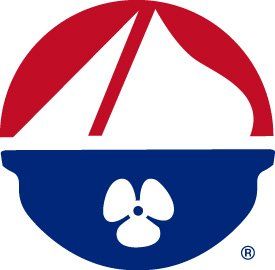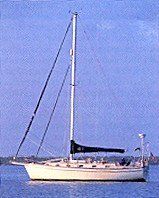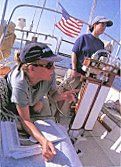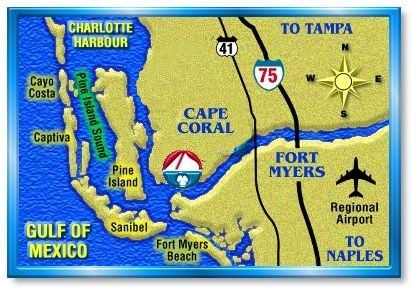


Sail Girls
The following article is taken from the November 1998 Issue of Sail Magazine
The Charter Girls
by Allison Peter
Photography by Skip Brown
For a group of new-to-Florida Charterers, Pine Island Sound (squall and all)
was a great place in which to gain confidence and learn some seamanship.

The author (steering),
Aimee (foreground),
Gaelen, and Tracy sailing
on the Gulf Of Mexico.

Day breaks on fishermen casting their nets in the shallows behind Useppa Island.
All it lacked was a film crew and a voice-over. We were really and truly a National Geographic special. Spiky pink bolts crackled sideways, almost in time with the bowling-alley thunder; the rain, also horizontal, stung our faces and frothed the water white; the wind gusts buffeted our boat, eventually flipping our inflatable dinghy.
This was the first night of our cruise and our first time anchoring Windquest III, an Island Packet 38. Three other SAIL staffers, Gaelen Phyfe, Aimee Curran, and Tracey Farina, and I had chartered Windquest from Southwest Florida Yachts in anticipation of a quiet, relaxing week in Pine Island Sound. This first night was a trial by squall, and we passed the test. Our CQR held as did our Bruce which we lowered overboard mid-squall. The storm went on its way after two hours of nail-biting, listening to NOAA weather, and checking the rode for chafe, and we knew we could anchor with confidence thereafter.
Gaelen, a dinghy racer and a transatlantic veteran veteran (three times on a Swan 47), and I, a sometime charterer and also a dinghy racer, were nervously responsible for this charter. The idea of chartering in Florida in May with two of our coworkers was appealing, of course, but I'd always chartered with someone who had more experience than I. Gaelen knew how to pilot and set an anchor but had always been able to rely on other people's knowledge and experience. We hadn't ever been the ones fully responsible for a boat and crew.

As it turned out, Pine Island Sound was an ideal cruising ground for gaining confidence. Several barrier islands protect the sound from the Gulf of Mexico, minimizing the effects of winds and waves. The area's anchorages and marinas are close enough that piloting takes you where you want to go. And the Intracoastal Waterway (ICW), which runs the length of the sound and then cuts into the Caloosahatchee River on its way across Florida, is an easily identifiable highway on which to travel.
Because Windquest drew 5 feet, and because many parts of Pine Island Sound are considerably shallower than that, we spent a lot of time on the ICW. But unlike most U.S. highways, there's a lot to see and do from the lanes of the Waterway.
Cayo Costa, a park and wildlike refuge maintained by the state of Florida, is probably one of the most untouched ICW exits in this area. Completely undeveloped, it's home to myriad species of birds and trees, as well as dolphins, manatees, and wild pigs. We anchored on the Gulf side of Cayo Costa for lunch, a swim and a shell hunt (though not for keeping) one afternoon; as we ate sandwiches under the watchful eyes of a pelican, we imagined a Gilligan's Island-like scenario.
On either side of Cayo Costa (just down and up the ICW) are Gasparilla and Captiva islands. We didn't take time to visit the former, although we were told the biking is lovely, as is the gawking at the homes of the rich and famous. We did sail through Boca Grande Pass and gawk at the Boca Grande Lighthouse, though. Captiva, well known to landlubbing vacationers, is south of Cayo Costa and provides an entirely different kind of fun. Overlooking both the Gulf and the sound is South Seas Plantation, a pricy but comfortable resort with its own marina.
We spent a night on the docks at South Seas; after three days without either showers or ice cream, we felt it was acceptable to shell out the $5-plus-per-foot dockage fee.

It was here that we docked our 38-foot behemoth for the first time, I drove, Gaelen scampered around with the bow and stern lines, Tracey was Springline Girl, and Aimee stood ready to hold a fender between the boat and the pilings. It wasn't pretty, but we didn't break anything and no one got hurt, so we considered it a success. We met the South Seas harbormaster, Jack Counsell, who, upon learning that we were from Boston, wistfully said, "Ah, God's country" We knew we'd found a friend.
You know that sound you hear when you try to start your car and nothing happens? It's not really a sound, I guess, it's more of a silence. Well, we heard a lot of that on our charter. The cockpit engine starter worked only some of the time. Rather than call the charter company for help (which they would have cheerfully provided), we decided to deal with this "challenge" ourselves. When she needed to, Gaelen jumped the solenoid with a screwdriver, providing both her resourcefulness and her fearlessness (not that they were ever much in doubt). Jumping the solenoid became routine, and it was an example of a problem that fazed us in the beginning of the week but didn't at the end.
We had a different experience with the dinghy outboard. It worked fine, but it was really heavy, and it had a long way to be lowered. We eventually worked out a system: Aimee and I got in the dinghy; Tracey and Gaelen stayed on the boat. Aimee held the dinghy close to Windquest's stern while Gaelen and Tracey lowered the outboard down to me. I guided and secured it to the dinghy transom. A big sigh of relief completed the procedure.
Since we had become pretty speedy at putting the outboard on the dinghy, we decided midweek to anchor Windquest south of Useppa Island, a very private island for the very wealthy. Because it's off limits to cruisers, we dinghied across the ICW to Cabbage Key for lunch. The Cabbage Key Inn Restaurant/Marina is a fun stop for burgers, beers, or a walk on the nature trail (or all three, if that doesn't seem incongruous). We actually had water, salads, and a walk on the nature trail, but got a feel for the place nonetheless. American mystery writer Mary Roberts Rinehart, who published most of her work in the early twentieth century, visited here and was supposedly inspired enough by the island to write a few novels. As we walked the rustling, semi-overgrown trails, it wasn't too hard to see how Rinehart could have been moved to literary creation.

Rinehart is credited by devotees of the mystery genre as having created the "If I had only known"narrative device: "If I had only known that Cecil would be stabbed in the pantry, I would have discouraged him from indulging in his craving for cucumber sandwiches in the middle of the night." Hindsight, as all mystery characters (and nervous charterers) realize eventually, is a beautiful thing. If I had only known how pleasant Pine Island Sound, and how much fun being responsible for a charter would be, I would have come much sooner.
Sign up for updates!
Get news from Southwest Florida Yachts, Inc. in your inbox
Thank you for signing up.
Oops, there was an error joining.
Please try again later
By submitting this form, you are consenting to receive marketing emails from: Southwest Florida Yachts, Inc., 5991 Silver King Blvd, Suite 108, Cape Coral, FL, 33914, US, http://www.swfyachts.com. You can revoke your consent to receive emails at any time by using the SafeUnsubscribe® link, found at the bottom of every email. Emails are serviced by Constant Contact.


5991 Silver King Blvd, Suite 108
Cape Coral FL 33914
239.257.2788
1.800.262.7939
www.swfyachts.com
info@swfyachts.com
Tarpon Point Marina 26° 32' 14" N; 82° 00' 06" W

